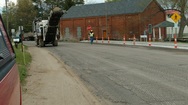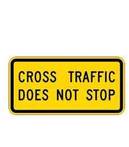 The Road Commission is pleased to announce that the Wing Hinge Bracket was the winner of
the 2016 Great Ideas Challenge. Michigan’s
Local Technical Assistance Program (LTAP) sponsors the contest to help
identify, share, and reward the great work that is performed by local road
agencies in Michigan. The entry will be submitted into the Build a Better Mousetrap National Competition that is sponsored by
FHWA.
Nearly all road agencies utilize wing plows attached to the side
of the plow truck as part of efficient winter maintenance operations. Since the
wings hang off the side of the truck, they take a lot of abuse and eventually start
to bow and cause damage to the mounting bracket. This makes it difficult to
remove the hinge pin and the wing plow loses its stability.
Tom Langeland, a mechanic from the Grand Haven garage, had a
great idea to give the wing plow more support at the mounting bracket on the
truck. A swivel mounting system was developed that allows for wing mobility
while still giving stability to the mounting system.
The following are some of the
benefits of the wing hinge bracket; the wing is more has become more stable,
the wing mounting bolt stays tight, there is less egg shaping of the mounting
center hole, and there is less chance of wing breaking off the side of the
truck. The wing hinge bracket system is safer for the public and the Road Commission
plow truck driver.
The bracket is very easy to
construct. The only materials that are needed include: ½” thick flat steel
stock around 15” X 23”, 5/8” flat steel stock about 10” X 5”, and steel bolt. The
only costs are materials and the time to cut and weld the steel, and assemble. The
only tools needed are a torch or plasma cutter, a welder, and a drill.
|
Even with the full opposition of the
County Road Association (CRA), the Michigan Association of Counties (MAC), and
the Michigan Township Association (MTA), the Michigan Senate still approved
Senate Bill 399 (S-3). This bill will impede all Michigan road agency’s ability to protect the integrity and
funding of the local road system while subsidizing the telecommunications
industry.
Michigan road agencies must ensure that work within the public road
right-of-way (ROW) is performed safely, does not damage the road
infrastructure, and meets engineering and road agency standards, along with
other federal and state requirements. The Road Commission issues permits to
work in the road right-of-way to protect the integrity of the county road
network and the safety of the traveling public.
County road agencies do not profit
by issuing permits, but simply recover the costs of issuing permits, making
site inspections and performing related tasks. SB 399 (S-3) limits the fees to $300 per
permit or $1,000 per project. Such a
“one-size-fits-all” fee does not account for the type of work planned, nor does
it consider the risks a project may pose to public safety, integrity of public
roads, or other public infrastructure. The bill supplants engineering-based ROW
management with a “cookie-cutter” approach that puts public resources at risk.
Over these summer weeks, the Road Commission
encourages you to contact your legislators and let them know what a serious
mistake SB 399 (S-3) is to public safety and the local road network and what a
negative impact it will have on Road Commission and all other road agency operations.
 Paved roads have a typical service life of 15 to 20
years, depending on the amount of traffic and weather conditions. Resurfacing
is a method of maintenance to preserve and improve driving conditions as well
as the aesthetics of the roadway. Hot mix asphalt resurfacing is a multi-step
process that usually involves several work crews, accompanied by proper
construction signs and work-zone traffic control measures to maintain public
safety. Prior to the resurfacing operations the following steps are required:
- Adjustment (lowering)
of manhole castings to allow milling machines to traverse the roadway.
- Removal (milling) of
old surface using a milling machine. Milling may not be required on all
streets; however, it is common to provide a milled joint at the start and end
of a resurfacing project.
- Re-adjustment
(raising) of manholes so that they will again be flush with the new road
surface.
- Sweeping of the
milled or existing paved surface.
- Application of a tack
coat to the milled or existing paved surface to serve as a binder for the resurfacing
materials.
Once the road surface is properly prepared, a paver is
utilized to evenly spread hot mix asphalt upon the
milled or existing road surface at a predetermined depth. The new surface is then thoroughly compacted by steel
tandem drum rollers.
|
 Will a stop sign slow down traffic on your
street?
A stop
sign placed at the right place and under the right conditions, tells drivers
and pedestrians who has the right of way. Stop signs installed at the wrong place for the wrong
purpose usually create more problems than they solve. One common misuse of stop
signs is to arbitrarily interrupt traffic, either by causing traffic to stop or
by causing such an inconvenience that motorists are forced to use other routes. Traffic studies indicate that there is a high
incidence of intentional violations where stop signs are installed as
"nuisances" or "speed breakers." The studies also show that
drivers increase their speeds between unwarranted stop signs to make up for the
lost time. Based on these studies and the increased speeds of drivers on
streets with unwarranted stop signs, the Michigan Manual of Uniform Traffic
Control Devices clearly states that "Stop signs shall not
be used for speed control."
|
 Can a “children at play” sign be placed on
your street?
At first consideration,
it might seem that a “children at play” sign would
provide some safety for youngsters playing in a neighborhood. Unfortunately,
this type of sign encourages parents to believe that children have an added degree of protection, which the signs do not and cannot
provide. Studies have shown there is no evidence that
this type of sign reduces vehicle speeds or collisions with pedestrians. Obviously, children should not be encouraged to play in the roadway. In contrast, the
"children at play" sign suggests that it is acceptable
to do so. Federal standards discourage the use of this sign. Additionally, this
sign is not recognized in Michigan’s traffic sign manuals. As an alternative, the Road Commission strives to remove vision
obstructions to provide a safe roadway for both pedestrians and motorists.
|
 How Effective Are Cross Traffic Warning Signs?
Cross traffic control signs and devices at intersections warn drivers that not all approaching vehicles are required to stop. Sometimes drivers on the "minor" roadway assume that drivers must also stop on the "major" roadway. While a number of factors may cause the resulting "right-angle" collisions, crash data show that some locations reported reduced accident frequency after installing cross traffic warning signs. Other locations reported no significant change. These signs are not standardized and are used inconsistently. Increasing the use of cross traffic signs may cause drivers to expect them and to assume that in their absence all traffic must stop. The research suggested that the signs would be helpful in locations where driver perceptions are a major factor in crashes and/or where rights-of-way have changed.
|
|